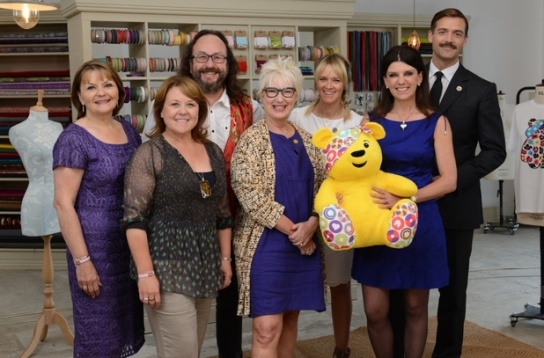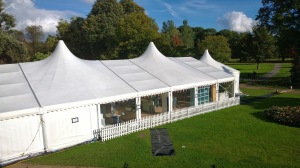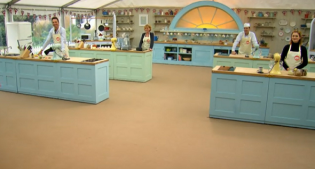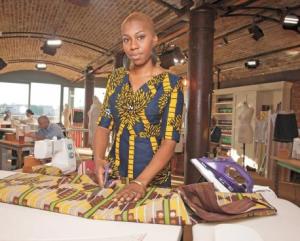So last week we were treated to three episodes of the Great British Sewing Bee for Children in Need. I love the Sewing Bee. It’s informative, the people are always really nice, and that haberdashery? I just want to jump straight in! It’s different from a lot of other things on television too – no sniping competitors like ‘the apprentice’, no talk of the ‘journeys’ people have been on like the big talent shows, no special favours given to age or beauty, and no ‘life-changing’ sums of money up for grabs, just a humble token prize and some lovely new friends. Do I sound jealous? I think might be.
The reason that I say it’s different from ‘most things’ because it is quite similar to the Great British Bake Off. Let’s face it, they couldn’t even think of a unique show title! As with GBBO we’ve got a male and a female judge (with the same initials), there are three challenges, the judging is somewhat subjective, and frequent attempts are made to ‘educate’ the audience throughout both shows. One interesting difference between the two is the setting – GBBO is in a tent in the grounds of an English manor house, GBSB in a gritty old London textile factory. Whereas GBBO gets pretty bunting and meadow flowers (plus the occasional squirrel), GBSB gets bare brick work and strip lighting. I sort of get it. But I sort of don’t. I’m just not really sure why anyone would bake intricate pastries in a tent, I think that’s the problem.
Bake off – lovely meadow and pastel kitchen stations
Sewing Bee – Gritty urban warehouse and exposed brickwork
The thing that does bother me about both of these programmes (but particularly the sewing bee) is the issue of time. In each episode participants (I just can’t get on board with ‘contestants’) are given a very specific time slot in which to make their garment – ‘You have 2 hours to make a skirt!’, ‘1 hour to modify this shirt!’, ‘5 hours to make a coat’, ‘GO GO GO’.
Arrrrgh!
The sociologist Richard Sennett once commented that:
in contemporary capitalism, production is based on speed; fast, short-term transactions; and constantly shifting deadlines and tasks – it is world where ‘craftsmanship sits uneasily’ (2006: 105).
For me this tension really comes to the fore in the Sewing Bee. The craft of sewing is about applying skills, learning to work with a variety of fabrics, stitches, materials, and other notions. And yet, good craft – well executed skills – take time. They take time to develop, and more often than not, time to do well. Now, I supposed the assumption behind the sewing bee is that participants have already put in the time to develop a library of skills which they can in some way just extract and ‘apply’ to the task presented to them. As those of you who read our piece on skilled practice will know, I’m really not a fan of this continual reinforcement of a mind-body divide. But that’s a topic for another post. My specific gripe here is with the way Sewing Bee participants are allocated the minimal amount of time for each challenge, and thus have to work as fast as they possibly can. Each task ends with a countdown, often forcing sewists to leave raw edges on their work, or parts of the garment missing. I remember being particularly cross about this in the first series of the Sewing Bee when Tilly Walnes didn’t get enough time to finish her beautiful blouse (from a self-drafted pattern!) and was (in my opinion) unfairly ejected from the competition. It just all seems to go against what craft is about.
Craft, for me at least, is about taking the time to exercise care in the construction process. It’s not simply about an active human subject imposing her will onto a piece of wood, fabric, or metal, but instead cooperating with, co-producing if you like, a finished article. The maker needs to get to know the material, listen to what it wants. A sewer, for instance, needs to know the drape of her fabric, know what its strengths and limitations are, work with grain lines, work around (or incorporate) imperfections… Even if on paper it is ideally suited for making a specific garment, in practice it might not want to be that. Knitters often talk about waiting for their yarn to tell them what it wants to be, and I think the same is true of materials other than yarn as well. Such a process of communication takes time – just as you get to know people, you need to get to know the materials with which you work.
The fingers that craft can only go as fast as they can go. There is no switch to flick for full power, no gears for them to move through. And yet rather than feeling like they are failing at being efficient, or desperately trying to shave a few minutes off of making time, most craftspeople learn to accept and inhabit this slow space in which things grow logically and methodically – one stitch, one cut, one piece at a time. Particularly for those of us who craft for personal pleasure (rather than a for-profit business venture), craft is about finding joy in the process of making rather than a focus on reaching the finish line. It thus becomes intensely personal – finding what works and what doesn’t (whether someone does an hour here, 20 minutes there, or a huge 7 hour crafting binge, what methods are effective, what shapes and colours suit), creating something that is valued for its absolute uniqueness and being able to take the time to do it as you want.
Not for the Sewing Bee contestants though. It’s all about that finish line, trying to please other people, and direct comparisons. It has to be watchable television, yes, but it needs to have substance too. If it’s supposed to be about racing through life as quickly as possible then I guess it succeeds. But if it’s supposed to be about craft and crafting a lifestyle, well, it’s not a craft that I recognise.




